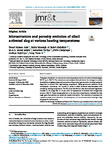Microstructure and porosity evolution of alkali activated slag at various heating temperatures
| dc.contributor.author | Aziz, IH | |
| dc.contributor.author | Abdullah, MMAB | |
| dc.contributor.author | Mohd Salleh, MAA | |
| dc.contributor.author | Yoriya, S | |
| dc.contributor.author | Chaiprapa, J | |
| dc.contributor.author | Rojviriya, C | |
| dc.contributor.author | Li, Long-yuan | |
| dc.date.accessioned | 2021-10-19T12:24:05Z | |
| dc.date.available | 2021-10-19T12:24:05Z | |
| dc.date.issued | 2020-11 | |
| dc.identifier.issn | 2238-7854 | |
| dc.identifier.issn | 2214-0697 | |
| dc.identifier.uri | http://hdl.handle.net/10026.1/18114 | |
| dc.description.abstract |
This paper elucidated the microstructural and porosity evolution of alkali activated slag at 800 °C up to 1200 °C. The microstructural analysis obtained shows the changes in surface densification of glassy phase and nucleation of dynamical grains within the alkali activated slag when in contact with high heating temperature. Using synchrotron radiation X-ray tomographic microscopy, the number of pores in alkali activated slag decreased with increasing heating temperature. The 3D pores distribution also demonstrated significant increase in the range size of ~20 mm with the appearance of isolated and intergranular pores at 1200 °C. These changes also led to the anorthite crystallisation indicated by high angle grain boundaries and preferred crystal orientation. The evolution of porosity and crystalline phase is contributed to the development of internal strain after heating at high temperature environment. | |
| dc.format.extent | 15894-15907 | |
| dc.language | en | |
| dc.language.iso | en | |
| dc.publisher | Elsevier | |
| dc.subject | Alkali activated slag | |
| dc.subject | Porosity | |
| dc.subject | Crystallisation | |
| dc.subject | Electron backscatter diffraction | |
| dc.title | Microstructure and porosity evolution of alkali activated slag at various heating temperatures | |
| dc.type | journal-article | |
| dc.type | Journal Article | |
| plymouth.author-url | https://www.webofscience.com/api/gateway?GWVersion=2&SrcApp=PARTNER_APP&SrcAuth=LinksAMR&KeyUT=WOS:000606462600012&DestLinkType=FullRecord&DestApp=ALL_WOS&UsrCustomerID=11bb513d99f797142bcfeffcc58ea008 | |
| plymouth.issue | 6 | |
| plymouth.volume | 9 | |
| plymouth.publication-status | Published | |
| plymouth.journal | Journal of Materials Research and Technology | |
| dc.identifier.doi | 10.1016/j.jmrt.2020.11.041 | |
| plymouth.organisational-group | /Plymouth | |
| plymouth.organisational-group | /Plymouth/Faculty of Science and Engineering | |
| plymouth.organisational-group | /Plymouth/Faculty of Science and Engineering/School of Engineering, Computing and Mathematics | |
| plymouth.organisational-group | /Plymouth/REF 2021 Researchers by UoA | |
| plymouth.organisational-group | /Plymouth/REF 2021 Researchers by UoA/UoA12 Engineering | |
| plymouth.organisational-group | /Plymouth/Research Groups | |
| plymouth.organisational-group | /Plymouth/Research Groups/Marine Institute | |
| plymouth.organisational-group | /Plymouth/Users by role | |
| plymouth.organisational-group | /Plymouth/Users by role/Academics | |
| dcterms.dateAccepted | 2020-11-14 | |
| dc.rights.embargodate | 2021-10-20 | |
| dc.identifier.eissn | 2214-0697 | |
| dc.rights.embargoperiod | Not known | |
| rioxxterms.funder | European Commission | |
| rioxxterms.identifier.project | Partnership for Research in Geopolymer Concretes | |
| rioxxterms.versionofrecord | 10.1016/j.jmrt.2020.11.041 | |
| rioxxterms.licenseref.uri | http://www.rioxx.net/licenses/all-rights-reserved | |
| rioxxterms.licenseref.startdate | 2020-11 | |
| rioxxterms.type | Journal Article/Review | |
| plymouth.funder | Partnership for Research in Geopolymer Concretes::European Commission |


